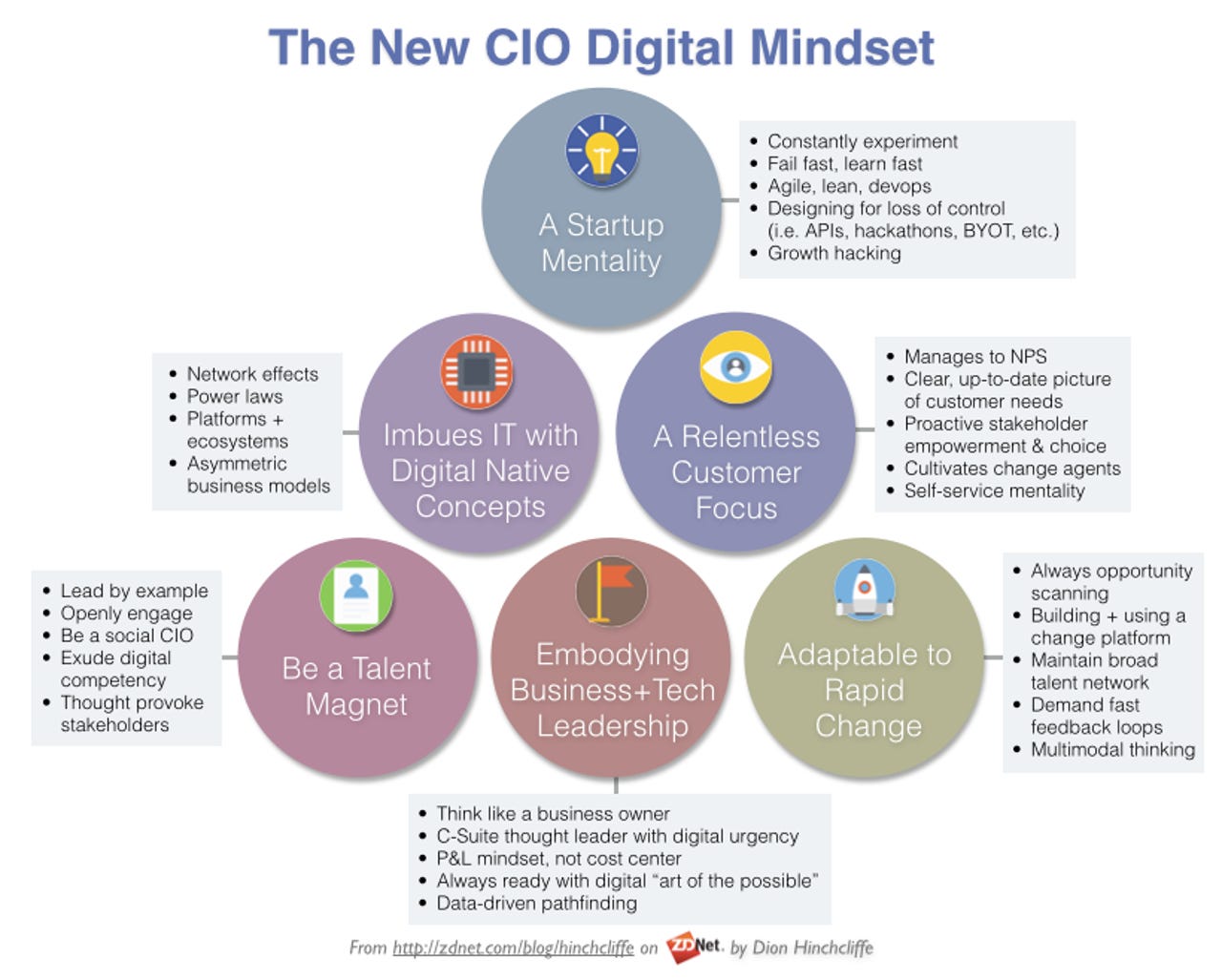A new generation of CIO thinking emerges

The data keeps piling up: Tech spending and digitization of the enterprise is happening outside of IT as never before. There's no easy way to say it: The role of the CIO to lead the tech enablement of our organizations is steadily eroding as strategic technology decisions are more rapidly being made elsewhere in the organization.
At the top of the organization, we have other C-level roles, including the CMO and the emerging chief digital officer (CDO), making IT investments and growing their budgets like never before. On the ground are lines of business that are buying/building their own solutions while departments and individuals steadily bring in new so-called renegade "shadow IT" apps and services to solve urgent business problems with emerging tech solutions.
Case in point in terms of industry data on this shift: Well-known research firm Altimeter just published a digital transformation study that shows that the CMO role is in fact significantly more likely than the CIO to to lead large scale tech change within the business. While I'd suggest Altimeter probably has more access to marketing leaders than IT leaders (probably influencing the breakdown a bit), this data is not by any means unique: Gartner has pegged the amount of IT not under CIO control at up to 90% by 2020 in its forecasts. Even if off by as much as half, such data clearly indicate that the CIO purview will have a minority internal marketshare soon.

Tech Investment Matters, As Does Wielding It In New Ways
Most CIOs should regard these data points -- as well as the relatively flat growth of IT budgets, despite operating in an era of all time greatest tech change -- as nothing short of the proverbial canary in the coal mine: There is just too much technology to roll out and too much demand for finer grained, more tailored solutions within the business. Any informal sampling of the product market maps of tech sectors in the enterprise sector -- this includes big data, marketing software, Internet of Things, artificial intelligence, conversational UXs, robotics, you name it -- shows vast, non-linear proliferation and growth.
In short, the metabolism of our traditional IT processes is now too slow, too limited, and too rigid to meet today's highly demanding, incredibly fast-paced operating environments. But if every IT organization had the same problem, it would at least be a barrier for everyone and a level playing field. However, it turns out that some organizations, as McKinsey has found in its recent analysis of digital industry leaders, are doing much better than everyone else in terms of technology enablement and transformation.
The dream of many CIOs, however, is still for massive economies of scale, easily managed and governed one-size-fits-all IT systems, all delivered via complex, monolithic enterprise suites, industry clouds, and stacks whose parts all work together while requiring little customization to meet baseline -- though usually common denominator -- business needs.
In direct contrast, the constituents that actually run the business increasingly demand tailored solutions that more directly meet their needs in an increasingly competitive markets that tolerate little delay and/or poor adaptation to day-to-day operational realities and/or fast-rising customer expectations. In other words, the extensive and growing backlog of IT projects in most organizations is steadily pushing the business side en masse to seek other ways to meet their needs for digitization.
New Models of IT Emerging, Slowly but Steadily
Of course, most CIOs are generally aware of this state of affairs, but up until recently we've lacked concrete evidence of workable alternative models for next-generation IT. What is clear now is that centralized IT departments methodically rolling out new IT solutions for every stakeholder in the organization using only their budgeted capabilities, typically a mere 3-6% of company revenue -- combined with a few representatives from the business -- is a recipe for significant underperformance when compared to industry leaders. Digital leaders, however, spend over twice as much on average on IT and then make it work for them in new and better ways that traditional organizations often aren't prepared to do.
This result is a vast and unsustainable gap in tech investment that has been inexorably separating the leaders and the laggards well apart for some time. Yet nearly every IT leader I speak to says they have virtually no ability to meaningfully increase their IT budgets, as top firms continue to greatly outspend their less digitally-advanced rivals.
However, while it's critical over time for IT's efforts to match the scale of tech change, it turns out that the size of the IT budget is likely not the most important factor in being a digital leader. Significantly more impactful appears to be the nature of how top organizations think about IT and their role in it. In my experience, most of today's digital leaders appear to function in novel and highly differentiated new ways than traditional IT organizations.
Thus, a new combined mindset and operational model appears key to fully realizing technology in our organizations. These concepts go well beyond the incremental talk today on how to accelerate IT, such as useful yet relatively linear concepts such as bi-modal and multi-modal IT, devops, and the shift to the CIO as a value broker. Digital leaders go past these ideas and borrow approaches from the very best in the industry.
Yet many CIOs are still operating to yesteryear's era of top-down, traditional do-it-all-yourself model of IT that is stuck in a project-based mentality rather than an ecosystem-based one. In contrast, I find that leading IT organizations think about service delivery using a much different digital-native, emergence-seeking, and customer-centric mindset.
It's clear that the next 10 years will change businesses more than the last 40 years. The writing is on the wall, as half of CEOs now say that their enterprise will have changed very substantially or become almost unrecognizable by 2020, noted a widely-read recent essay on the new IT mindset by Gartner's Graham Waller.
The New Digital Mindset for IT
In my research, these then seem to be the hallmarks of a new mindset the emerging among CIOs and IT leaders in leading organizations:
- A startup mentality. The Internet startup industry is one of the most incredible incubators for technology and supporting processes that has so far emerged. Out of thousands of major experiments over the last 20 years, a great deal has been done to codify the lessons of startup creation, the technologies they use, the processes they employ, and then systematize what worked best. This has resulted in a dramatic reduction in the cost of developing technology products and services over the years for organizations large and small. It is now a whopping three orders of magnitude cheaper to create technology solutions since the year 2000 according to calculations by experts. Many IT departments today now aspire to an startup mentality to access these benefits and greatly magnify the power of their budgets. One good example of this is Principal Financial Group's CIO Gary Scholten, who has adopted a minimum viable product (MVP) approach to developing their financial services. The MVP approach is a favorite startup tactic that gets a very basic product to market and then learns quickly from customers directly about what they actually need in terms of evolving the product with new features. Many CIOs have also rolled out formal processes to strategically partner with startups to access to their technologies and ideas.
- Imbues IT with digital native concepts. The next-gen IT department understands the underlying rules of digital and the power laws that make it so much more powerful than traditional marketplaces. As all businesses become technology companies, the top of the digital food chain consists of platforms and ecosystems powered by network effects. There are now plenty of examples of traditional companies that understand these rules and are diligent to directly shape their business strategy with them. We can look to examples of this like Walmart's Developer Network to platform their business or the much-faster-than expected rollout of blockchain technology by financial services firms to tap into fast growing new open ecosystems.
- A relentless customer focus. I often point to Watermark's excellent yearly study which measures the significant benefits of focusing on customer experience leadership through creating an engaging, compelling, straightforward journey through the relationship between an organization and its customers. Again last year, top performers greatly outpaced the market as a whole just as digital experience is rapidly becoming the primary venue where customer experience must be delivered. Industry leaders tend to be in retail and other market-facing industries, with examples like Nordstrom as well as Burberry particularly standing out. In this new mindset, customer satisfaction (internal and external both) is regularly measured and fed directly back into all processes. This new mindset sincerely regards stakeholder happiness as the highest measure of success, as SAP's CIO Thomas Saueressig recently told me he did. As my fellow ZDNet columnist Michael Krigsman observes, there is high ROI in customer experience.
- Being a talent magnet. Being a digital leader requires a team that can deliver, and that means talent that can ride the technology change curve. These are continuous learners with an innovative spirit, that can repeatably take smart risks with digital experiments. The new IT leader will walk this walk, model the behavior they want to see, and exude stakeholder and workforce leadership through combined technology and business savvy. Noted CIO recruiter Martha Heller notes that there is a serious talent paradox today, in that we seek multifaceted Renaissance IT staff that are versatile and can do whatever is needed as technology changes, yet that talent usually just isn't available . Worse, high priority operational issues often prevent strategic hiring processes from having adequate resources. In my experience, I find that a new generation of star CIOs is emerging that are highly engaged, social and visible not just in their company but across the industry. Because of this they have unique reach and access to talent that less engaged CIOs don't have, including the power to retain it like few others through their leadership, openness, and engagement. This afford them access to top talent that has competitive significance.
- Embodying business and technology leadership. The new CIO leads the business from the front by taking their knowledge of the art of the possible to the C-Suite and the board while painting a clear picture of the strategic options and digital future. While operations remains critical, CIOs will be much more involved in business strategy and product direction. A good example of this is CIO Klas Bendrik of automobile manufacturer Volvo Cars, who works directly with the CEO of the company to set direction and identify digitally-driven new services and ventures.
- Adaptable to rapid change. As I've noted recently, the most effective IT leaders will cultivate and wield purpose-built platforms for change (often based on community and other digital engagement models) matched with data-driven decision making processes. With an unblinking eye for emerging opportunities and empowering change agents, I've previously cited IT organizations at the FCC, AstraZeneca, Graham Holdings, IBM, and others as organizations amenable to faster the normal change processes along with progressive stance towards new IT models.
Is this a complete model of where IT is headed? Almost certainly not, but it provides a good glimpse of what it will require to a) successfully ride the rapidly moving treadmill of tech change, b) help organizations make the transition to better ways to more fully digitize, c) play to the strengths of the digital universe to growth and retain share of market, and d) avoid disruption in the process. I'd be thrilled to hear your examples in comments below.
Additional Reading
The digital transformation conversation shifts to how
IT leaders a 'catalyst' to bring together digital transformation